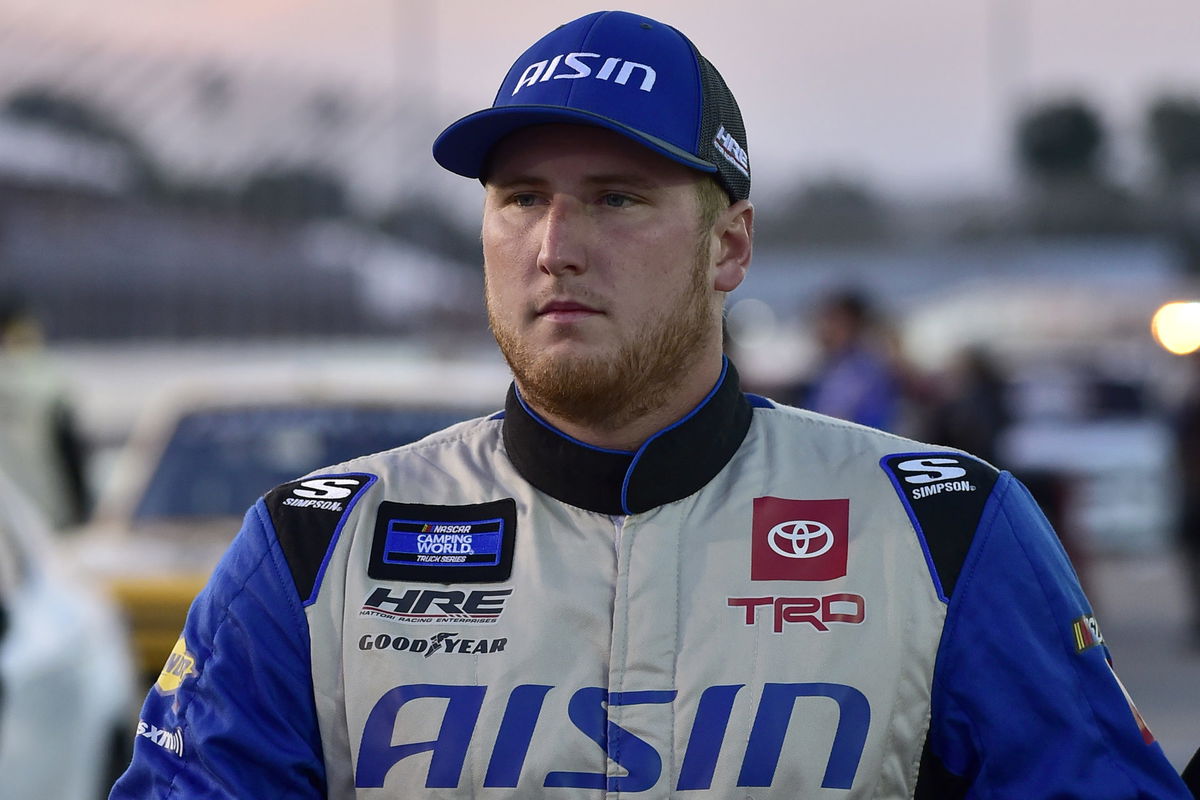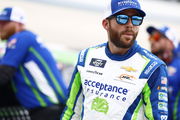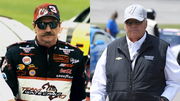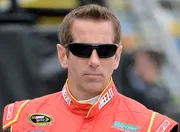
Getty
MADISON, ILLINOIS – AUGUST 20: Austin Hill, driver of the #16 AISIN Toyota, walks the grid prior to the NASCAR Camping World Truck Series Toyota 200 presented by CK Power at Gateway Motorsports Park on August 20, 2021 in Madison, Illinois. (Photo by Jeff Curry/Getty Images)

Getty
MADISON, ILLINOIS – AUGUST 20: Austin Hill, driver of the #16 AISIN Toyota, walks the grid prior to the NASCAR Camping World Truck Series Toyota 200 presented by CK Power at Gateway Motorsports Park on August 20, 2021 in Madison, Illinois. (Photo by Jeff Curry/Getty Images)
Austin Hill’s recent return to NASCAR racing has been marked by intense competition and a string of contentious moments that have stirred strong reactions from fans, drivers, and commentators alike. Navigating the high stakes of the Xfinity Series, Hill came back on the track after serving a suspension, aiming to showcase his racing prowess and secure his position for the playoffs. However, rather than a smooth comeback, his races have been punctuated by heated incidents that have tested the boundaries of aggressive driving and sportsmanship.
Watch What’s Trending Now!
The Watkins Glen race, in particular, became a focal point for debate, following a spectacular crash involving Hill that drastically altered the race’s outcome. This series of controversial on-track moments raises questions about responsibility, racing ethics, and the fine line drivers walk between assertiveness and recklessness in pursuit of victory.
ADVERTISEMENT
From suspension to spotlight: Hill’s return ends in chaos
Austin Hill found himself under the spotlight again at Watkins Glen International shortly after returning from a one-race suspension, which he had served due to a crash involving Aric Almirola at Indianapolis Motor Speedway. During the recent race, Hill was engaged in a fierce battle for the runner-up position alongside Michael McDowell.
What started as a tight battle for second place on Lap 74 at Watkins Glen quickly turned into one of the wildest moments of the 2025 Xfinity Series season. Austin Hill, in the No. 21 RCR Chevy, made a bold move exiting Turn 5 but clipped Michael McDowell’s No. 11 Kaulig car. McDowell slammed into the barrier, bounced across the track, and triggered a massive 16-car pileup that took out several playoff contenders. The red flag came out as crews worked to clear the mess, and in a rare move, CW cut away from the race to air live interviews with both drivers.
Hill explained that his approach was a calculated risk, trying to capitalize on a massive run to catch McDowell off guard. He admitted to lifting his foot slightly from the throttle but acknowledged it was “not enough” to avoid contact, which unfortunately resulted in a massive wreck involving multiple cars.
ADVERTISEMENT
Hill was candid and blunt in his assessment, accepting blame for the incident while emphasizing that there was no malicious intent behind his move. He noted, “Just two guys going for it. Nothing malicious, as much as everybody wants to sit there and try to make it more than it is. It was just two guys racing it out. I was trying to get by the 88 [Connor Zilisch] as quickly as I could because the 88 was driving away from us, and I thought that we could maybe have a shot at racing with him and racing for the win there. I had a massive run off the Carousel. I kind of thought I was trying to catch [McDowell] off guard and get to his left side”. He also revealed a sense of frustration about the situation, expressing regret about the wreck happening after his return from suspension and how it impacted not just his race but several others.
Hill reflected, underscoring the split-second decisions drivers face, and the risks inherent in competitive racing, “The grass was coming up in front of us. I had to get to the right. I was kind of hoping he was going to move to the right and kind of give me some room, and it just didn’t happen. But if everyone wants to blame me for it, I’ll take the blame for it”
ADVERTISEMENT
“Nothing malicious… it just was two guys racing it out.” @_AustinHill accepted blame for the late-race melee that started with contact with @Mc_Driver. #NASCAR pic.twitter.com/rfnDq7SNDt
— Frontstretch (@Frontstretch) August 9, 2025
Michael McDowell, the other driver involved, described the impact as unfortunate: “I felt like I got two good restarts there and was able to get back and take it clean,” McDowell told The CW. “I didn’t rough up the No. 21 at all, but it just kinda felt like he kept trying to move me there in the carousel. I can see here, [Hill] was never going to get alongside [me] there, I was on the way out, he wasn’t even alongside, he just turned me.”
Both drivers had been racing cleanly until that moment, but the contact abruptly ended McDowell’s race and triggered a multi-car pileup. The incident underscored how even unintentional mistakes at high speeds can have dramatic consequences, sparking discussion across the NASCAR community about driver responsibility and the challenges of road course racing.
ADVERTISEMENT
Top Stories
Ross Chastain Labels NASCAR Driver “The Most Punchable Face” to Excuse Himself Over Punchgate Controversy

Jimmie Johnson Poaches Richard Childress’ Key Ally Ahead of NASCAR 2026 Season

When Rick Hendrick Walked Away From $1,000 to Avoid Dale Earnhardt Sr’s Wrath

NASCAR’s Next Big Villain Named as Denny Hamlin Enters Fans’ Good Books

Brad Keselowski & Co. Pays Emotional Tribute to Greg Biffle With Special No. 16 Memorabilia

Implications of Hill’s racing style and NASCAR’s stance
Austin Hill’s involvement in consecutive controversies has placed him at the center of ongoing debates about driving conduct and NASCAR’s disciplinary measures. His recent crash at Watkins Glen is not an isolated case; it followed the suspension he served for intentionally wrecking another driver just weeks earlier. This pattern has raised concerns among fellow drivers, commentators, and fans regarding Hill’s aggressive style and whether it crosses the line into recklessness.
Despite Hill’s apology and acceptance of responsibility, some voices in the NASCAR community remain critical of his decisions on the track. “When you intentionally wreck somebody, we don’t realize that could k–l that person.” Mark Martin commented on the suspension of Austin Hill. This illustrates the fine line NASCAR officials walk in balancing driver aggression with safety and sportsmanship regulations.
ADVERTISEMENT
Hill acknowledges the severity of his recent racing conduct and the consequences it has had on his standing, especially given the playoff implications. “It wasn’t done on purpose.” Austin said, in a conversation with reporter Dustin Albino, He elaborated: “I know that when I go to my grave way down the road that it wasn’t done on purpose.”
With three victories to his name in the current Xfinity Series season, Hill’s position in the playoff bracket is precarious, made worse by lost points from his suspension and the fallout from the Watkins Glen crash.
The incident at Watkins Glen has reignited discussions about track design and safety, particularly regarding runoff areas and their influence on driver behavior. Drivers, including McDowell, point out that paved runoff zones allow for aggressive moves but can also lead to accidents from sudden corrections. This underscores the challenge of balancing speed, safety, and competition in NASCAR. Austin Hill’s recent controversies highlight the pressures in racing, with his acceptance of responsibility for the Watkins Glen crash contributing to the ongoing conversation within the racing community.
ADVERTISEMENT
ADVERTISEMENT
ADVERTISEMENT
ADVERTISEMENT

